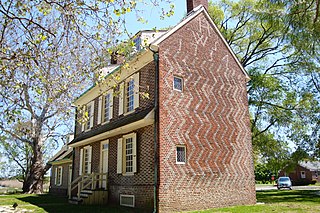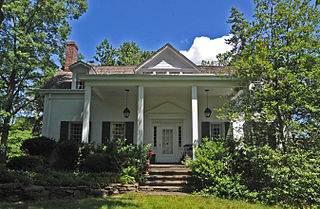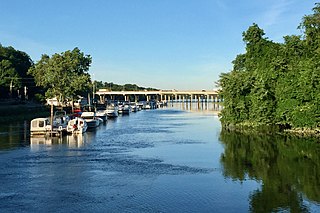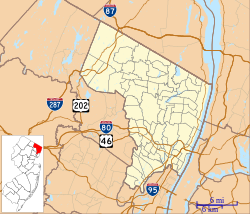
Ridgefield is a borough in Bergen County, New Jersey, United States. As of the 2010 United States Census, the borough's population was 11,032, reflecting an increase of 202 (+1.9%) from the 10,830 counted in the 2000 Census, which had in turn increased by 834 (+8.3%) from the 9,996 counted in the 1990 Census.

Ridgefield Park is a village in Bergen County, New Jersey, United States. As of the 2010 United States Census, the village's population was 12,729, reflecting a decline of 144 (−1.1%) from the 12,873 counted in the 2000 Census, which had in turn increased by 419 (+3.4%) from the 12,454 counted in the 1990 Census. Of 565 municipalities statewide, Ridgefield Park is one of only four with a village type of government in New Jersey, though it operates a Walsh Act form of government. Of the four New Jersey villages Loch Arbour also uses the commission form of government, while Ridgewood operates under the council-manager form, and the Township of South Orange Village operates under a special charter form with many characteristics of village government.

Weir Farm National Historical Park is located in Ridgefield and Wilton, Connecticut. It commemorates the life and work of American impressionist painter J. Alden Weir and other artists who stayed at the site or lived there, to include Childe Hassam, Albert Pinkham Ryder, John Singer Sargent, and John Twachtman.
New Bridge was a prosperous mill hamlet, centered upon a bridge strategically placed at the narrows of the Hackensack River. In the American Revolution, New Bridge Landing was the site of a strategic bridge crossing the Hackensack River, where General George Washington led his troops in retreat from British forces November 20, 1776. Eleven engagements took place here throughout the war. The current Draw Bridge at New Bridge was installed in 1889 and added to the National Register of Historic Places on July 5, 1989. The area is now a New Jersey historic site in portions of New Milford, River Edge, Hackensack and Teaneck in Bergen County, New Jersey, United States.

The Steuben House is a noted example of Bergen Dutch sandstone architecture, located at New Bridge Landing on the Hackensack River in River Edge, in Bergen County, New Jersey, United States.

The Wallace House is a Georgian style historic house, which served as the headquarters of General George Washington during the second Middlebrook encampment (1778–79), located at 38 Washington Place, Somerville, Somerset County, New Jersey, United States. It was added to the National Register of Historic Places on December 2, 1970.

The Campbell-Christie House is a historic home that has been relocated to New Bridge Landing in River Edge, Bergen County, New Jersey. It was added to the National Register of Historic Places on January 10, 1983, as part of the Early Stone Houses of Bergen County Multiple Property Submission (MPS).

The table below includes sites listed on the National Register of Historic Places in Bergen County, New Jersey except those in Closter, Franklin Lakes, Ridgewood, Saddle River and Wyckoff, which are listed separately. Latitude and longitude coordinates of the sites listed on this page may be displayed in a map or exported in several formats by clicking on one of the links in the box below the map of New Jersey to the right.

The Hancock House is a historic structure in the Hancock's Bridge section of Lower Alloways Creek Township, Salem County, New Jersey, United States. It was the site of the 1778 Hancock's Bridge massacre. The site is on the National Register of Historic Places.

The Hermitage, located in Ho-Ho-Kus, Bergen County, New Jersey, United States, is a fourteen-room Gothic Revival house museum built in 1847–48 from designs by William H. Ranlett for Elijah Rosencrantz, Jr. Members of the Rosencrantz family owned The Hermitage estate from 1807 to 1970. The site was designated a National Historic Landmark for the excellence of its architecture and added to National Register of Historic Places in 1970. In 1971 it was added to the New Jersey Register of Historic Places.

The Van Wagenen House, also known as Apple Tree House, is located near Bergen Square in Jersey City, Hudson County, New Jersey, United States. The house was added to the National Register of Historic Places on August 16, 2006.
The English Neighborhood was the colonial-era name for the towns in eastern Bergen County, New Jersey, along the Hudson Palisades between the Hudson River and the Hackensack River, particularly around its main tributary, Overpeck Creek. The region had been part of the Dutch New Netherland colony of Bergen, whose main town was located at Bergen Square in today's Jersey City. The name speaks to the geography of the region, bergen being the Dutch word for hills. Earlier attempts at settlement at Achter Col and Vriessendael had been compromised in conflicts with the precolonial population, bands of the Lenape known by their exonyms, the Hackensack and the Tappan.

Demarest House is located in River Edge, Bergen County, New Jersey, United States. The house was added to the National Register of Historic Places on January 10, 1983, as part of the Early Stone Houses of Bergen County Multiple Property Submission (MPS).

The Martin Berry House is located in Pompton Plains in Pequannock Township, Morris County, New Jersey, United States. The house was built in 1720 and added to the National Register of Historic Places on June 19, 1973. Built by the son of one of the first settlers to the Pompton River region, the pre-Revolutionary War building has been little altered since its construction.

The Peter Huyler House is located on what is known as the Captain John Huyler Homestead at 50 County Road between Palisades Avenue and Crest Drive North in Cresskill, Bergen County, New Jersey. In 1776, the property was part of a 180-acre (73 ha) farm which belonged to Loyalist John Ackerson or Eckerson. It was confiscated in 1779 because of Ackerson's loyalty to the British, and sold in 1784 to Captain John Huyler of the local militia. Huyler's son Peter built the main wing of the current house in 1836, according to the date stone over the door, with what was described by the Bergen County Stone House Survey as "some of the finest stonework in Bergen County". The outbuilding was most probably a summer kitchen, with quarters for slaves.

The Homestead Farm at Oak Ridge is a historic house and grounds located in Oak Ridge Park in the township of Clark in Union County, New Jersey and extending into the township of Edison in Middlesex County. It was listed on the National Register of Historic Places on October 25, 1995, for its significance in architecture, exploration/settlement, law, military history, and politics/government. In addition to the building, the listing includes three contributing sites and one contributing object.

Pleasant Valley is an unincorporated community located within Marlboro Township in Monmouth County, New Jersey, United States. The area reportedly received its name from George Washington after he went through the area in 1777. The area is hilly and forested and is dotted by medium to large-sized residences. Pleasant Valley Road and Reids Hill Road are main roads that pass through the area connecting to Routes 34, 79, and 520. A large part of land which makes up Pleasant Valley was originally granted by the King of England in 1665 to the Rev. Obadiah Holmes. In 1690, the area was settled by people of Dutch heritage and the original dominant language in the area was Low Dutch.

The Van Horne House is a historic building at 941 East Main Street near Bound Brook in Bridgewater Township, Somerset County, New Jersey. The house was built c. 1750 and also known as Phil's Hill, after its owner, Philip Van Horne. It served as the headquarters for American General Benjamin Lincoln in 1777, during the American Revolutionary War, in particular the Battle of Bound Brook. Later, it served as the headquarters for American General William Alexander, Lord Stirling during the second Middlebrook encampment (1778–79). The house, on the early-18th-century Old York Road that connected Philadelphia to New York City, was a New Jersey landmark during the war. Since 2002, the Heritage Trail Association has used the house as its headquarters, including an exhibit space. It was added to the National Register of Historic Places on March 8, 2002, for its locally significant Colonial Revival architecture from 1937 to 1944.

The Crosswicks Creek Site III is a historical archaeological site in the vicinity of Bordentown in Burlington County and Hamilton Township in Mercer County, New Jersey. It encompasses the remains of Revolutionary War-era ships that were sunk in Crosswicks Creek in 1778. The site was listed on the National Register of Historic Places on November 26, 1990 for its significance in military and maritime history.

The Craig House is a restored Revolutionary War era farmhouse. In June 1778, it was used by the British Army as a hospital during the Battle of Monmouth. It is one of many 18th century farmhouses that have been preserved at Monmouth Battlefield State Park. The Craig House is located in Freehold Township in Monmouth County, New Jersey. Monmouth Battlefield is administered by the New Jersey State Park Service.





















